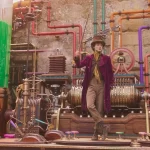The Invisible Man: What You See and What You Get, by Tyler Smith

One of the reasons that the horror genre endures is its adaptability. Artistic style may change, but the things that scare us don’t. No matter where or when a person may live, at his core, he’s still frightened by the same things as the rest of us. Death and disease are old stand-bys, but there is also the general fear of the unknown; the feeling that there’s more going on than we’re able to perceive. The limitation of our own senses is what author H.G. Wells was exploring in his 1897 novel The Invisible Man, and it captured the imaginations of generations of horror and science fiction fans. And starting with James Whale’s 1933 adaptation, Hollywood has been fascinated not only by the dynamic of fearing what we can’t see, but also of the impact of invisibility on the morality and actions of those characters bold enough to experiment with it. And now we have Leigh Whannell’s The Invisible Man, a film that has virtually nothing in common with the novel of the same name, but still feels like a beautiful modern realization of Wells’ earlier concepts. The film is frightening, stressful, and engaging. It is one of the best horror films in recent memory.
The story kicks it into high gear immediately, as Cecilia (Elisabeth Moss) quietly sneaks away from her sleeping boyfriend. As she grabs a bag full of clothes and and medication, we realize that she’s not merely sneaking away; she’s actually leaving him. Then, as she turns off multiple cameras and punches in security code, we realize that she’s not merely leaving him, but fleeing. She eventually escapes, but is soon afraid to leave her friend’s house, even just to check the mail. Her boyfriend, Adrian, has been physically, emotionally, and psychologically controlling, often to the point of abuse, and has done such a number on her that, when word gets back to her that he has killed himself, she still feels his oppressive presence in her life. She becomes convinced that he is still alive, but has managed to somehow turn himself invisible. Her friends, however, think that she is slowly losing her mind. Soon enough, she is alone, with her previous sources of support driven from her life.
It soon becomes apparent that The Invisible Man is a chilling symbol of those relationships that are so unbearable that every moment becomes its own little horror film. The term “gaslighting” has become much more common in modern culture, referring to the insidious practice of convincing a reasonable person that they are in fact going insane. That this practice is common in romantic relationships – with one person assuring their partner that they’re not experiencing abuse, but are simply overreacting – is a sad statement about the way that people can come to regard each other as objects to be manipulated rather than people to be loved.
The film is tight as a drum, but Whannell understands when to slow things down and let the camera quietly drift. When dealing with invisibility, even an ordinary empty room can take on ominous tones. In this way, the film is akin to David Robert Mitchell’s It Follows, which also dealt with an indistinct enemy that can come from anywhere. The film is also inspired by Polanski’s Repulsion and Soderbergh’s Unsane. This isn’t to say that the film is unoriginal; on the contrary, the way that Whannell incorporates these other films into his vision feels fresh and current.
The cast is fairly small, but each performer dutifully plays their role, rising above the familiar note of incredulity to imbue their characters with real, lived-in humanity. But, obviously, this is Elisabeth Moss’s showcase all the way, and she is a pleasure to watch. This is a difficult role for any performer. Too far in one direction and the perceived insanity comes too much to the forefront, but too far in the other and the constant fear threatens to become repetitive. And, as the character begins to figure out what’s really going on, Moss must once again restrain herself, lest her process seem too easy and more of a function of the screenplay than the character.
With so many traps to fall into, it makes her achievement all the more remarkable. Moss approaches the character not through the lens of overcoming fear, but of revelation and recollection. Cecilia is a bold, intelligent woman who has been so thoroughly wounded by her boyfriend that she has completely forgotten her own strength. But, with each narrative beat, she remembers who she really is, as opposed to the woman her boyfriend turned her into. To say the role is empowering is a bit reductive, because it still acknowledges the vulnerability and sadness at the core. It is a well-written character, beautifully realized by Moss, who has emerged in the last few years as one of the most interesting and reliable actors working today.
And so we get back to this idea of adaptability. That Leigh Whannell could look at the familiar story of an Invisible Man and see the opportunity to engage with a current cultural conversation is inspired. But it’s not unusual. The extreme concepts and stylings of horror allow all sorts of cultural and political ideas to be explored in ways that are organic and overt. It can be reimagined and reshaped to suit any time and place without ever seeming too obvious. This is provided, of course, that the director keep his focus on the execution, which counterintuitively will enhance his thematic vision rather than bury it. With The Invisible Man, Whannell has reminded us just how effective even the most familiar horror can still be when done right.





























